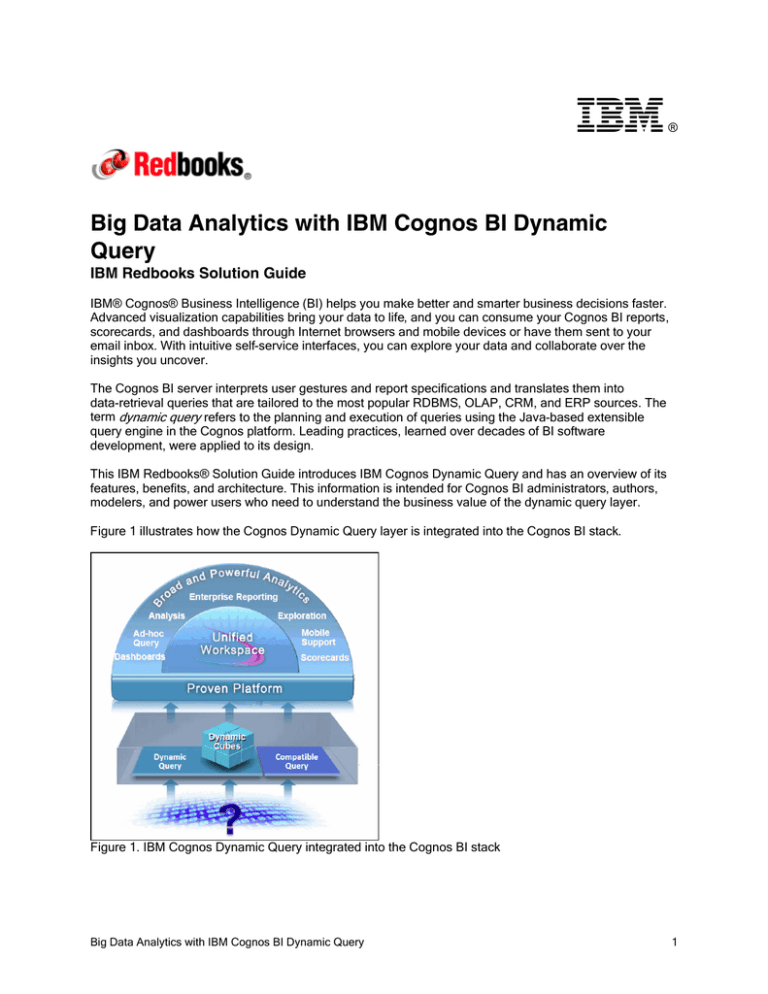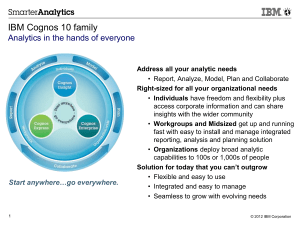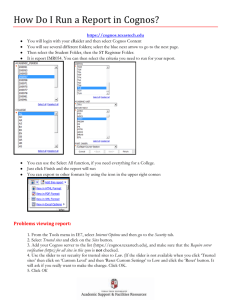
®
Big Data Analytics with IBM Cognos BI Dynamic
Query
IBM Redbooks Solution Guide
IBM® Cognos® Business Intelligence (BI) helps you make better and smarter business decisions faster.
Advanced visualization capabilities bring your data to life, and you can consume your Cognos BI reports,
scorecards, and dashboards through Internet browsers and mobile devices or have them sent to your
email inbox. With intuitive self-service interfaces, you can explore your data and collaborate over the
insights you uncover.
The Cognos BI server interprets user gestures and report specifications and translates them into
data-retrieval queries that are tailored to the most popular RDBMS, OLAP, CRM, and ERP sources. The
term dynamic query refers to the planning and execution of queries using the Java-based extensible
query engine in the Cognos platform. Leading practices, learned over decades of BI software
development, were applied to its design.
This IBM Redbooks® Solution Guide introduces IBM Cognos Dynamic Query and has an overview of its
features, benefits, and architecture. This information is intended for Cognos BI administrators, authors,
modelers, and power users who need to understand the business value of the dynamic query layer.
Figure 1 illustrates how the Cognos Dynamic Query layer is integrated into the Cognos BI stack.
Figure 1. IBM Cognos Dynamic Query integrated into the Cognos BI stack
Big Data Analytics with IBM Cognos BI Dynamic Query
1
Did you know?
Over 2.5 quintillion bytes of data are created daily.
The architects working on the design of the Cognos query engine literally have multiple decades (over
25 years) of experience in business intelligence.
The lessons learned over decades of leading the BI industry culminated in the design of this next
generation query engine.
Business value
The success of your business depends on your ability to analyze information, quickly find the right
answers, and make timely responses. To meet this challenge, IBM® Cognos® Business Intelligence
provides an enhanced Java-based query execution mode.
The heart of the Cognos platform is its service-oriented architecture (SOA). It is built on a true set of
peer-to-peer services that are interoperable and extensible through standard interfaces and protocols.
This feature enables organizations to consume their big data analytics through the Web, mobile devices,
or via e-mail right to the user's in-box. A low footprint, highly automated solution that can distribute the
content mindful of security however your users want to consume it; whether it be through a browser or
mobile device.
Big Data Analytics with IBM Cognos BI Dynamic Query
2
Table 1 outlines benefits of the dynamic query mode for common business problems organizations are
facing today.
Table 1. How the dynamic query mode helps your organization
Business problem
Solution
Your organization has or is moving to Java-based
architectures and you require JDBC or Java
connectivity to data sources.
The dynamic query mode provides expanded data
reach to support connectivity to various data
sources. New data sources are frequently added.
More database vendors exclusively support 64-bit
platforms. You want your applications to take
advantage of your investment in 64-bit technology.
The IBM Cognos Business Intelligence query
platform supports 64-bit environments, which
provide better memory management and improved
scalability and performance.
Business users want to quickly find answers when With the dynamic query mode, business users get
looking at information. The IT organization wants to the correct information quickly without
provide this capability while maintaining the
compromising security.
security of the applications.
In-memory caching stores both the query plan and
the query results while maintaining the security
permissions for each user.
Your organization invested in OLAP and relational
technologies and you want to optimize and gain
the maximum value from your investment.
The dynamic query mode provides optimized
access to OLAP data sources. It provides
customized and enhanced MDX for the specific
source and version of your OLAP technology, and
it harnesses the intelligence of the OLAP data
source.
The dynamic query mode provides SQL generation
optimizations for relational data sources.
It is a challenge to easily troubleshoot what
happens when a query is planned and executed.
The dynamic query mode provides detailed logging
and query visualization. IBM Cognos Dynamic
Query Analyzer enables you to visualize the logs
and helps you troubleshoot.
Solution overview
IBM Cognos Business Intelligence provides reports, analysis, dashboards, and scorecards to help
support the way people think and work when they are trying to understand business performance. You
can freely explore information, analyze key facts and quickly collaborate to align decisions with key
stakeholders.
The Cognos BI server interprets user gestures and report specifications and translates them into
data-retrieval queries that are tailored to the most popular RDBMS, OLAP, CRM, and ERP sources. The
term dynamic query refers to the planning and execution of queries using the Java-based extensible
query engine in the Cognos platform. Leading practices, learned over decades of BI software
development, were applied to its design. Dynamic query retains result sets and metadata captured from
optimized queries to data sources in a 64-bit, in-memory cache. It can reuse these result sets and
metadata to minimize the wait times for future requests.
Big Data Analytics with IBM Cognos BI Dynamic Query
3
The dynamic query layer was developed to meet requirements for interactive reporting and ad hoc
analysis. It employs sophisticated, multiphase query optimization techniques and can dynamically
alternate between SQL and MDX processing, depending on what best suits the scenario. Dynamic query
has a number of advantages. Advanced in-memory caching and aggregation can reduce data warehouse
workload. Users are provided with a consistent experience, no matter what the data source. In addition,
simple cache administration and query visualization tools help reduce total cost of ownership. IT
organizations can also take advantage of improved query performance thanks to the reduction in query
planning and execution, along with lighter database server workloads.
The dynamic query layer refers to the query service of IBM Cognos 10, which is powered by an extensible
query engine written in Java. The query layer offers the following key capabilities:
Open access to the most popular RDBMS, OLAP, CRM, and ERP data sources
Query optimization techniques to address complex analytical requirements, large and growing data
volumes, and expectations for timeliness
Enterprise-level scalability and stability
Intelligent combinations of local and remote processing
Federation of multiple heterogeneous data sources
OLAP functionality for relational data sources when using a dimensionally modeled relational (DMR)
package or Cognos Dynamic Cubes
Security-aware caching
64-bit processing
JDBC connectivity to relational data sources
Query visualizations for ease of maintenance
New projects in IBM Cognos Business Intelligence version 10.2.1 and later are set to dynamic query
mode, which is powered by an eXtensible Query Engine (XQE) written in Java. XQE, the engine behind
the Cognos BI query service, embraces the principles of abstraction and extensibility, allowing it to evolve
into a more efficient query planner, processor, and executor with every new version of IBM Cognos BI.
Solution architecture
Figure 2 shows the internal architecture of the query service, which consists of the following major
components:
Transformation engine and transformation libraries
Query execution engine
Metadata cache
Data cache
RDBMS and OLAP adapters
Big Data Analytics with IBM Cognos BI Dynamic Query
4
Figure 2. Internal architecture of the query service
The transformation engine does not implement any query planning logic by itself. Instead, it provides an
execution environment for query transformations in the transformation libraries, thus separating planning
logic from the engine. The transformations implement query planning logic for all supported query types
and functionality. When there are no more transformations to be applied, query planning is complete and
the transformation engine passes the resulting run tree to the query execution engine.
The query execution engine can execute any query request, independent of the type of query and target
data source. The engine represents all query results in memory in a single format that encompasses both
dimensional style (with axes, dimensions, and cells) and relational style (with a tabular format of rows and
columns). This allows the engine to combine SQL and MDX queries in a single run tree, thus enabling
simplicity of representation, flexibility in post-processing, and streamlined query performance. To process
the two types of queries, the query execution engine contains both SQL and MDX engines.
The SQL engine obtains data directly from the RDBMS adapter. The query execution engine updates the
secure data cache with dimensional data for future reuse. The MDX engine obtains dimensional data
either directly from the OLAP adapters or from the data cache. It also updates and reuses dimensional
metadata in the secure member cache. The cache security features ensure that, by default, no sharing of
secured data ever occurs between users with different security profiles.
The RDBMS and OLAP adapters translate IBM Cognos SQL and MDX queries to a query dialect suitable
and optimized for each data provider. The adapters send the query and fetch results through the
provider’s proprietary interface or a supported standard interface such as JDBC. There is only one
RDBMS adapter, which uses a JDBC interface, because all supported relational providers are accessible
through JDBC. The RDBMS adapter supplies data to the SQL engine in the query execution engine; the
OLAP adapters supply data to the MDX engine.
Big Data Analytics with IBM Cognos BI Dynamic Query
5
Usage scenarios
IBM Cognos offers several query technologies to address your analytical needs. This section provides
guidance that will lead you to the best solution for your requirements.
Table 2 summarizes the guidance regarding when to employ pure relational, IBM Cognos TM1®, Cognos
Dynamic Cubes, or DMR analytics for different application objectives.
Table 2. Summary of analytic technology selection guidance
Application objective
Preferred technology
Reporting on leaf-level records
Static reports (no user requirements for
navigating through business hierarchies)
Simple list reports
Pure relational
Users writing back to the same data source
being analyzed
What-if analysis
Volatile data due to planning and budgeting
applications
IBM Cognos TM1
Self-service interactive analysis
IBM Cognos Dynamic Cubes
High performance on large and growing data
volumes
Data warehouse structured in star or snowflake
schema
Interactive analysis on operational or
transactional database
Tight control over caching
Tight control over security
Big Data Analytics with IBM Cognos BI Dynamic Query
Dimensionally modeled relational (DMR)
6
Integration
IBM Cognos Dynamic Query is tightly integrated into the Cognos Business Intelligence stack, and its data
can be surfaced through any of the Cognos interfaces. With this method, existing customers can integrate
this technology into their application environment without affecting existing users. Such users are already
familiar with interfaces such as Report Studio, Business Workspace, and Business Workspace Advanced
(previously named Business Insight and Business Insight Advanced).
The query service accepts data and metadata requests (through the report service component) from
authoring interfaces such as IBM Cognos Report Studio, IBM Cognos Report Viewer, and other clients. It
returns the requested data or messages in a structured response to the report service component that
formats the result for the client. Figure 3 presents the workflow of requests and responses between these
components.
Figure 3. Query service request and response workflow
Supported platforms
For information about software environments that are supported in IBM Cognos Business Intelligence
V10.2.1, see the IBM Cognos Business Intelligence 10.2.1 Supported Software Environments web page:
http://www.ibm.com/support/docview.wss?uid=swg27037784
Big Data Analytics with IBM Cognos BI Dynamic Query
7
Ordering information
Ordering information is listed in Table 3.
Table 3. Ordering program numbers and program names
Program number
Program name
5724-W12
IBM Cognos Business Intelligence V10.2.1
5724-W68
IBM Cognos Business Intelligence PowerPlay® V10.2.0
5724-W19
IBM Cognos Business Intelligence Reporting V10.2.0
5724-W13
IBM Cognos Data Manager V10.2.0
5724-W20
IBM Cognos Mobile V10.1.0
Related information
For more information, see the following documents:
IBM Cognos Dynamic Query, SG24-8121
http://www.redbooks.ibm.com/abstracts/sg248121.html
IBM Cognos Dynamic Cubes, SG24-8064-00
http://www.redbooks.ibm.com/abstracts/sg248064.html
Big Data Analytics with IBM Cognos Dynamic Cubes, TIPS0942
http://www.redbooks.ibm.com/abstracts/tips0942.html?Open
IBM Cognos Business Intelligence V10.1 Handbook, SG24-7912
http://www.redbooks.ibm.com/abstracts/sg247912.html?Open
IBM Cognos Business Intelligence V10.1: Intelligence Unleashed, REDP-4693
http://www.redbooks.ibm.com/abstracts/redp4693.html?Open
Cognos Business Intelligence 10.2.1 documentation
http://www.ibm.com/support/docview.wss?uid=swg27037021
IBM Cognos Business Intelligence 10.2.1 information center
http://pic.dhe.ibm.com/infocenter/cbi/v10r2m1/index.jsp
Cognos software product page
http://ibm.com/software/analytics/cognos/
IBM Offering Information page (announcement letters and sales manuals)
http://www.ibm.com/common/ssi/index.wss?request_locale=en
On this page, enter IBM Cognos Business Intelligence, select the
information type, and then click Search. On the next page, narrow your
search results by geography and language.
Big Data Analytics with IBM Cognos BI Dynamic Query
8
Notices
This information was developed for products and services offered in the U.S.A.
IBM may not offer the products, services, or features discussed in this document in other countries. Consult your local
IBM representative for information on the products and services currently available in your area. Any reference to an
IBM product, program, or service is not intended to state or imply that only that IBM product, program, or service may
be used. Any functionally equivalent product, program, or service that does not infringe any IBM intellectual property
right may be used instead. However, it is the user's responsibility to evaluate and verify the operation of any non-IBM
product, program, or service. IBM may have patents or pending patent applications covering subject matter described
in this document. The furnishing of this document does not give you any license to these patents. You can send
license inquiries, in writing, to:
IBM Director of Licensing, IBM Corporation, North Castle Drive, Armonk, NY 10504-1785 U.S.A.
The following paragraph does not apply to the United Kingdom or any other country where such provisions are
inconsistent with local law : INTERNATIONAL BUSINESS MACHINES CORPORATION PROVIDES THIS
PUBLICATION "AS IS" WITHOUT WARRANTY OF ANY KIND, EITHER EXPRESS OR IMPLIED, INCLUDING, BUT
NOT LIMITED TO, THE IMPLIED WARRANTIES OF NON-INFRINGEMENT, MERCHANTABILITY OR FITNESS
FOR A PARTICULAR PURPOSE. Some states do not allow disclaimer of express or implied warranties in certain
transactions, therefore, this statement may not apply to you. This information could include technical inaccuracies or
typographical errors. Changes are periodically made to the information herein; these changes will be incorporated in
new editions of the publication. IBM may make improvements and/or changes in the product(s) and/or the program(s)
described in this publication at any time without notice.
Any references in this information to non-IBM Web sites are provided for convenience only and do not in any manner
serve as an endorsement of those Web sites. The materials at those Web sites are not part of the materials for this
IBM product and use of those Web sites is at your own risk.IBM may use or distribute any of the information you
supply in any way it believes appropriate without incurring any obligation to you. Information concerning non-IBM
products was obtained from the suppliers of those products, their published announcements or other publicly available
sources. IBM has not tested those products and cannot confirm the accuracy of performance, compatibility or any
other claims related to non-IBM products. Questions on the capabilities of non-IBM products should be addressed to
the suppliers of those products. This information contains examples of data and reports used in daily business
operations. To illustrate them as completely as possible, the examples include the names of individuals, companies,
brands, and products. All of these names are fictitious and any similarity to the names and addresses used by an
actual business enterprise is entirely coincidental.
Any performance data contained herein was determined in a controlled environment. Therefore, the results obtained
in other operating environments may vary significantly. Some measurements may have been made on
development-level systems and there is no guarantee that these measurements will be the same on generally
available systems. Furthermore, some measurement may have been estimated through extrapolation. Actual results
may vary. Users of this document should verify the applicable data for their specific environment.
COPYRIGHT LICENSE:
This information contains sample application programs in source language, which illustrate programming techniques
on various operating platforms. You may copy, modify, and distribute these sample programs in any form without
payment to IBM, for the purposes of developing, using, marketing or distributing application programs conforming to
the application programming interface for the operating platform for which the sample programs are written. These
examples have not been thoroughly tested under all conditions. IBM, therefore, cannot guarantee or imply reliability,
serviceability, or function of these programs.
© Copyright International Business Machines Corporation 2013. All rights reserved .
Note to U.S. Government Users Restricted Rights -- Use, duplication or disclosure restricted by
GSA ADP Schedule Contract with IBM Corp.
Big Data Analytics with IBM Cognos BI Dynamic Query
9
This document was created or updated on September 11, 2013.
Send us your comments in one of the following ways:
Use the online Contact us review form found at:
ibm.com/redbooks
Send your comments in an e-mail to:
redbook@us.ibm.com
Mail your comments to:
IBM Corporation, International Technical Support Organization
Dept. HYTD Mail Station P099
2455 South Road
Poughkeepsie, NY 12601-5400 U.S.A.
This document is available online at http://www.ibm.com/redbooks/abstracts/tips1057.html .
Trademarks
IBM, the IBM logo, and ibm.com are trademarks or registered trademarks of International Business
Machines Corporation in the United States, other countries, or both. These and other IBM trademarked
terms are marked on their first occurrence in this information with the appropriate symbol (® or ™),
indicating US registered or common law trademarks owned by IBM at the time this information was
published. Such trademarks may also be registered or common law trademarks in other countries. A
current list of IBM trademarks is available on the Web at http://www.ibm.com/legal/copytrade.shtml
The following terms are trademarks of the International Business Machines Corporation in the United
States, other countries, or both:
Cognos®
IBM®
PowerPlay®
Redbooks (logo)®
TM1®
The following terms are trademarks of other companies:
Java, and all Java-based trademarks and logos are trademarks or registered trademarks of Oracle and/or
its affiliates.
Other company, product, or service names may be trademarks or service marks of others.
Big Data Analytics with IBM Cognos BI Dynamic Query
10






